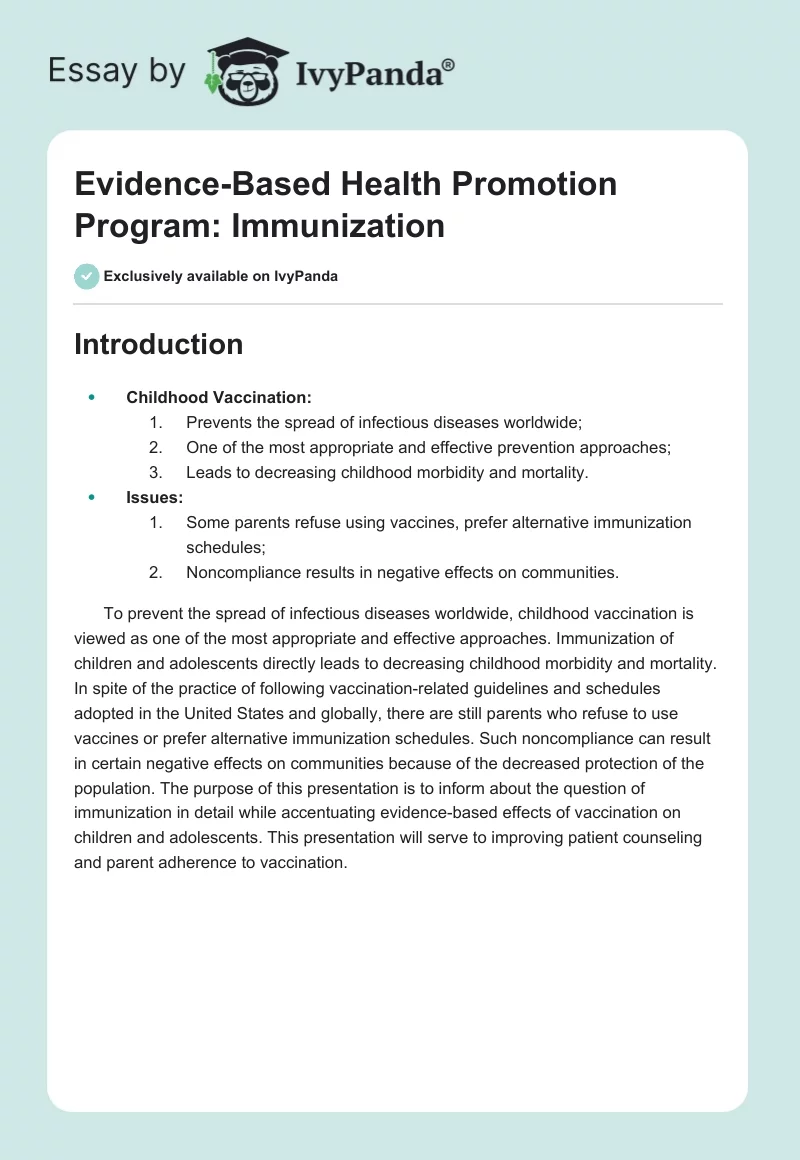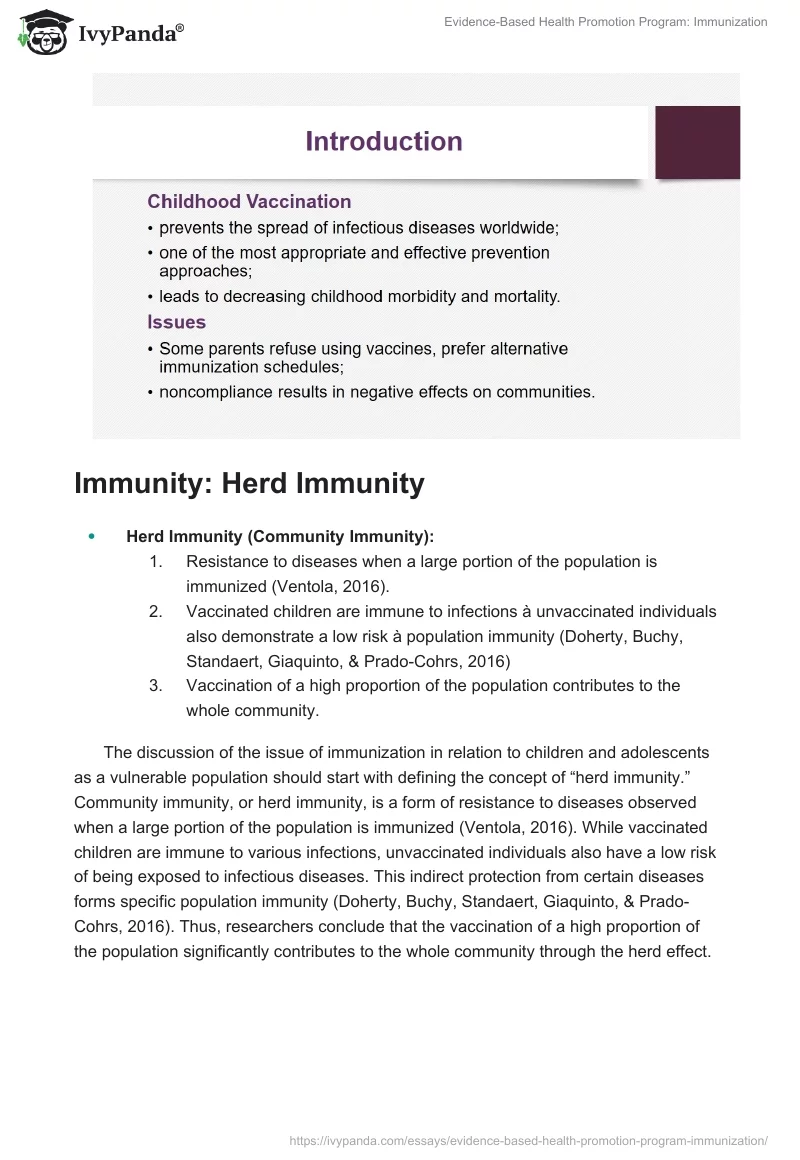Introduction
- Childhood Vaccination:
- Prevents the spread of infectious diseases worldwide;
- One of the most appropriate and effective prevention approaches;
- Leads to decreasing childhood morbidity and mortality.
- Issues:
- Some parents refuse using vaccines, prefer alternative immunization schedules;
- Noncompliance results in negative effects on communities.
To prevent the spread of infectious diseases worldwide, childhood vaccination is viewed as one of the most appropriate and effective approaches. Immunization of children and adolescents directly leads to decreasing childhood morbidity and mortality. In spite of the practice of following vaccination-related guidelines and schedules adopted in the United States and globally, there are still parents who refuse to use vaccines or prefer alternative immunization schedules. Such noncompliance can result in certain negative effects on communities because of the decreased protection of the population. The purpose of this presentation is to inform about the question of immunization in detail while accentuating evidence-based effects of vaccination on children and adolescents. This presentation will serve to improving patient counseling and parent adherence to vaccination.
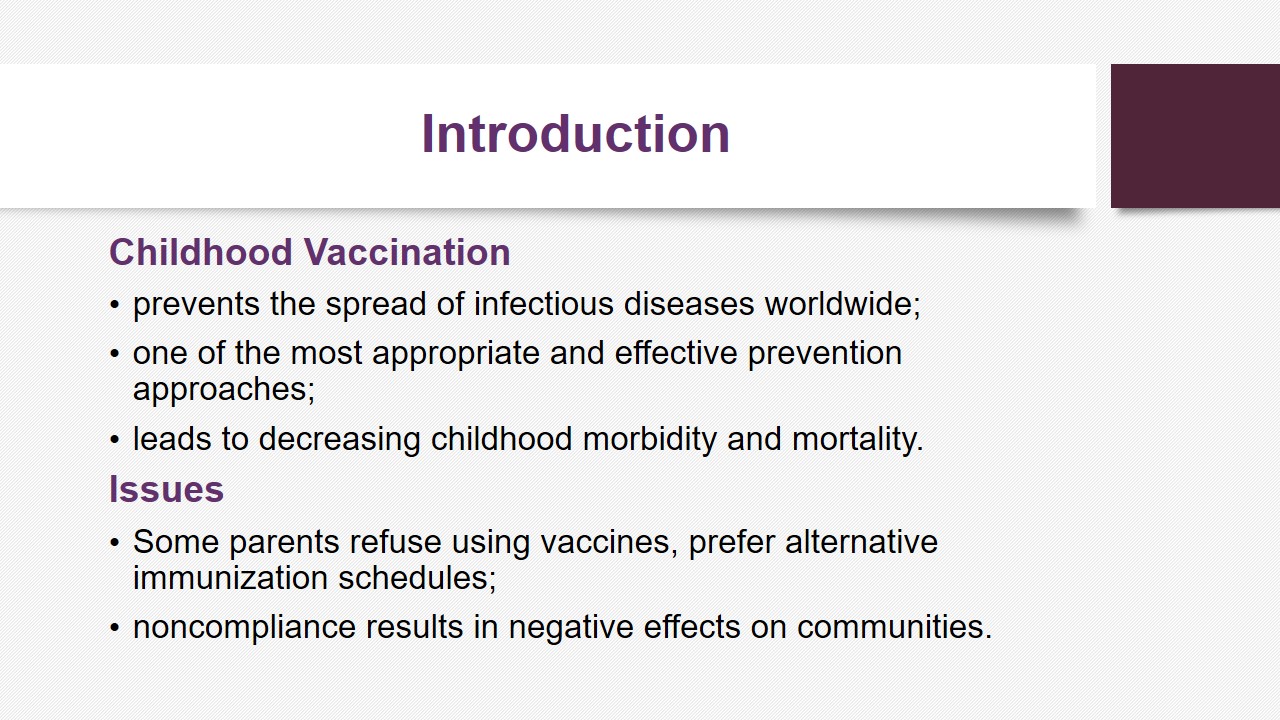
Immunity: Herd Immunity
- Herd Immunity (Community Immunity):
- Resistance to diseases when a large portion of the population is immunized (Ventola, 2016).
- Vaccinated children are immune to infections à unvaccinated individuals also demonstrate a low risk à population immunity (Doherty, Buchy, Standaert, Giaquinto, & Prado-Cohrs, 2016)
- Vaccination of a high proportion of the population contributes to the whole community.
The discussion of the issue of immunization in relation to children and adolescents as a vulnerable population should start with defining the concept of “herd immunity.” Community immunity, or herd immunity, is a form of resistance to diseases observed when a large portion of the population is immunized (Ventola, 2016). While vaccinated children are immune to various infections, unvaccinated individuals also have a low risk of being exposed to infectious diseases. This indirect protection from certain diseases forms specific population immunity (Doherty, Buchy, Standaert, Giaquinto, & Prado-Cohrs, 2016). Thus, researchers conclude that the vaccination of a high proportion of the population significantly contributes to the whole community through the herd effect.
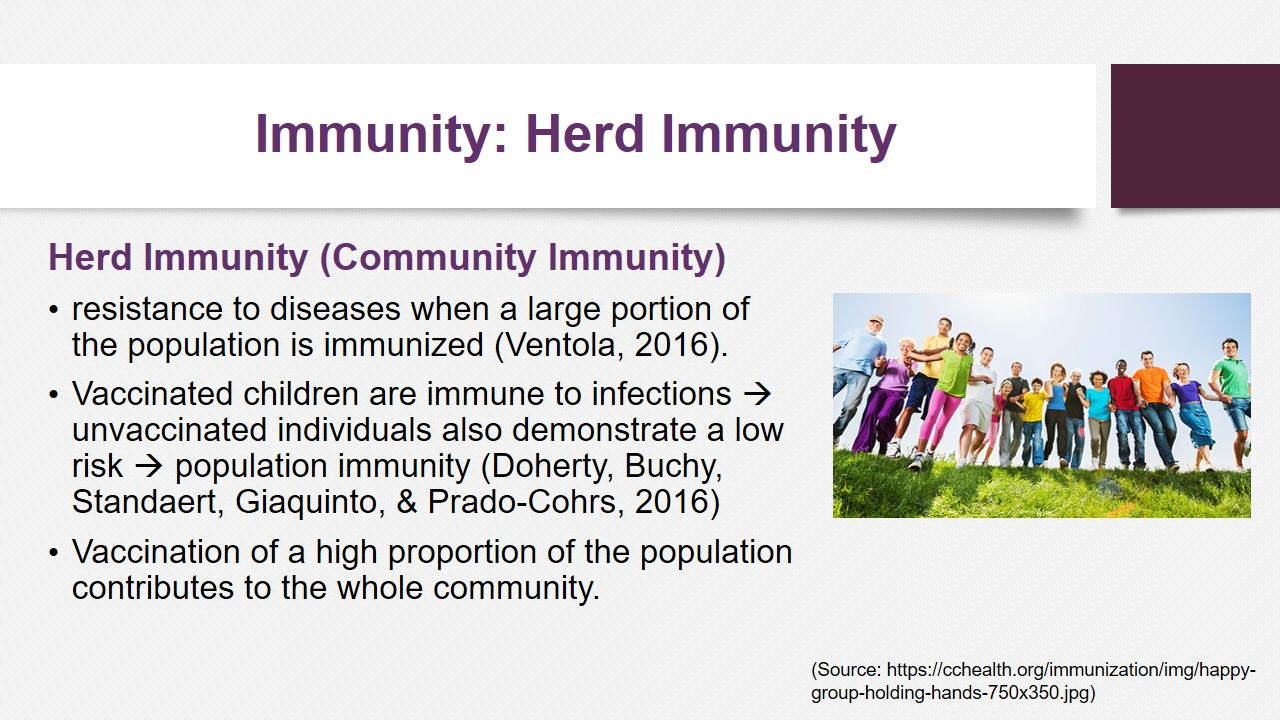
Immunity: Types of Immunity Related to Vaccination
Adaptive immunity: active and passive
- Active Immunity:
- Vaccines contain antigens to particular diseases.
- The immune system attacks antigens producing antibodies stored for a long time (Ventola, 2016).
- Vaccination leads to active immunity (Greenwood, 2014).
- Passive immunity:
- Receiving antibodies (for example, immune globulin) to attack antigens.
- Not related to vaccination.
- Works during a short period of time.
There are two types of adaptive immunity developed after being exposed to certain antigens: active and passive immunity. When an individual’s body meets antigens, antibodies are made by the immune system to attack these germs, and antibodies are stored for a long period of time (Ventola, 2016). Vaccination is related to the active adaptive type of immunity. When children are immunized, they are provided with a vaccine containing antigens to particular diseases, and their organisms start to produce antibodies that are stored for their future life (Greenwood, 2014). Passive immunity is associated with receiving antibodies (for example, immune globulin) to attack antigens only during a limited period of time, and it is not a result of vaccination.
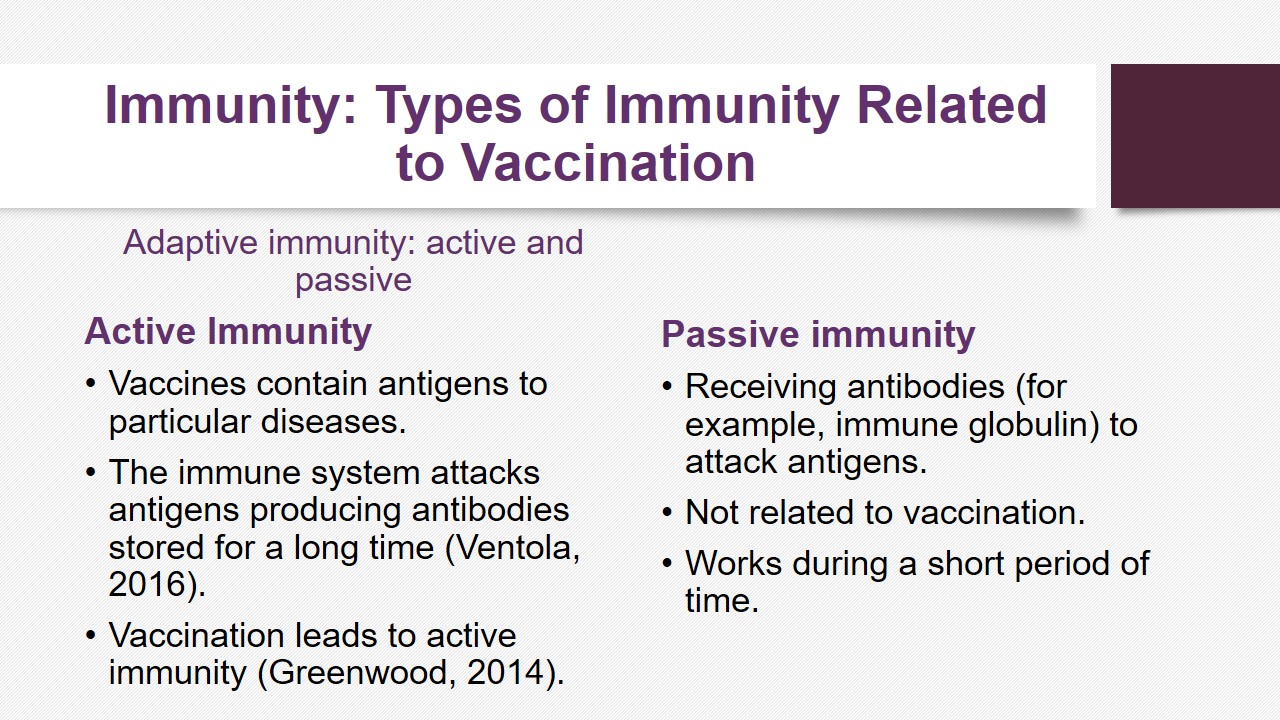
Effects of Immunization: Individual Effects
- Children and adolescents need to develop adaptive immunity through vaccination (Ventola, 2016).
Effects:
- The development of immunity to diseases by stimulating the production of antibodies to different antigens (MacDonald et al., 2018).
- Vaccination is a guaranteed protection from being exposed to dangerous diseases.
- Immunization programs serve to decrease childhood morbidity and mortality rates.
Individual effects of immunization for children and adolescents are numerous. They include the development of immunity to serious and even deadly diseases with the help of stimulating the production of antibodies to different types of antigens (MacDonald et al., 2018). It is important to note that children and adolescents are representatives of a vulnerable population, and they need to develop adaptive immunity through vaccination (Ventola, 2016). Furthermore, in most cases, vaccination is a guaranteed protection from being exposed to a dangerous disease. Immunization programs serve to decrease childhood morbidity and mortality rates.
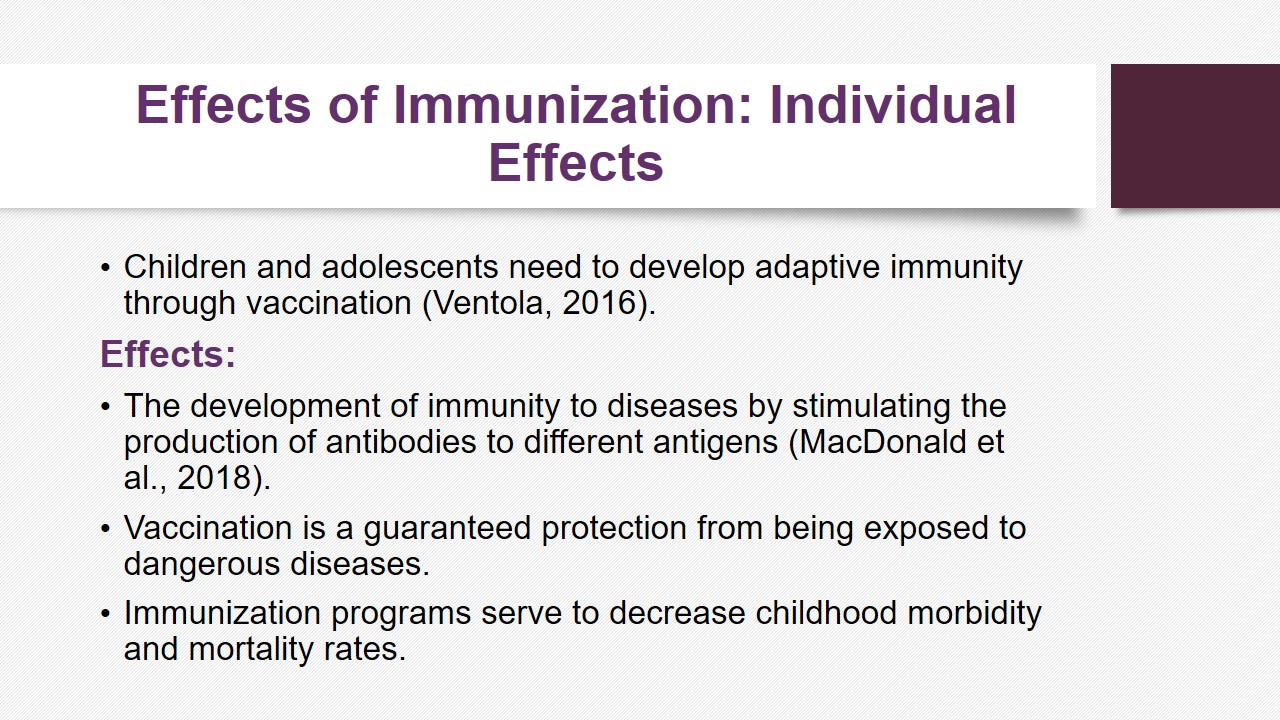
Effects of Immunization: Community Effects
- Development of herd immunity.
- Risks of being exposed to serious diseases decrease for all community members (Doherty et al., 2016).
- Epidemiology of pathogens within a community changes if immunization increases (Ventola, 2016).
- Effectively implemented immunization programs lead to improving community health (MacDonald et al., 2018).
- Prevalence of communicable diseases and morbidity and mortality among children decrease.
In addition to positive effects on individuals’ health, immunization also benefits communities through developing herd immunity. Risks of being exposed to serious diseases decrease for all members of a community where the majority of people are vaccinated (Doherty et al., 2016). Moreover, the epidemiology of pathogens within a community also changes if immunization among the population increases (Ventola, 2016). Effectively implemented immunization programs in communities lead to improving the health of such community members as children and adolescents (MacDonald et al., 2018). As a result, the prevalence of various communicable diseases as well as associated morbidity and mortality among children decrease significantly.

Effects of Immunization: Worldwide Effects
- Universal vaccination programs reduce the prevalence of infectious diseases in developed and developing countries (Greenwood, 2014).
- Decreases in mortality and morbidity associated with measles, rubella, mumps, pertussis, and tetanus.
- Declines in mortality caused by pertussis and tetanus (MacDonald et al., 2018).
- The worldwide vaccination coverage rate is under 100%, more immunization-related health promotion programs should be developed (Ventola, 2016).
The global availability of vaccinations has led to eradicating and eliminating diseases that were traditionally discussed as significant health threats a century ago. Currently, there are many universal vaccination programs that serve to reduce the prevalence of infectious diseases over the globe in not only developed but also developing countries (Greenwood, 2014). Worldwide effects of immunization include decreases in mortality and morbidity associated with such diseases as measles, rubella, mumps, pertussis, and tetanus. Researchers state that declines in mortality caused by pertussis and tetanus are direct effects of increased vaccination of the population (MacDonald et al., 2018). As a result, the risk of infectious diseases for children and adolescents in developing countries has decreased significantly. However, the worldwide vaccination coverage rate is still not 100%, which indicates the necessity of developing immunization-related health promotion programs (Ventola, 2016).
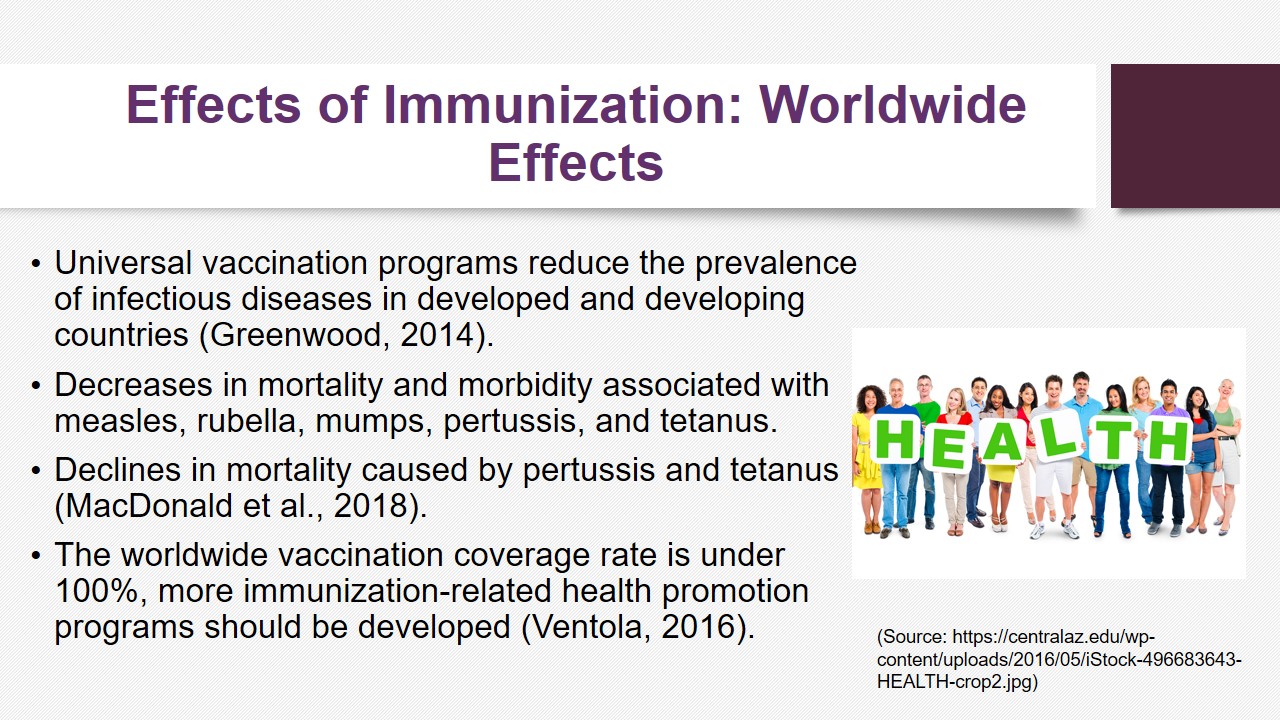
Trends in Vaccination
- To achieve the vaccination coverage in the United States and globally not below 90%.
- The rate of vaccination is correlated with a country’s GDP.
- Immunization in developing countries still remains an issue (Van Boven & Van Lier, 2016).
- Continuous development of new and improved vaccines to address more infectious diseases (e.g., vaccines against tuberculosis and HIV) (Greenwood, 2014; MacDonald et al., 2018).
- Some parents tend to refuse childhood vaccination (Ventola, 2016).
According to the recent trends in the area of immunization, the goal is to achieve the vaccination coverage in the United States and globally not below a safe level in 90%. This goal will be achieved in the near future because the global coverage has become higher. Traditionally, the rate of vaccination in a country is correlated with its gross domestic product (GDP), and immunization of children and adolescents in developing countries still remains to be an issue (Van Boven & Van Lier, 2016). One more trend is associated with continuous development of new vaccines to address more infectious diseases and improved vaccines to avoid side effects (MacDonald et al., 2018). Scientists also continue to work on developing vaccines from such complex conditions as tuberculosis and HIV (Greenwood, 2014). Still, there is also a trend among parents to refuse vaccination because of certain views and supporting some myths about immunization (Ventola, 2016).

Myths Related to Vaccination
- Vaccination causes significant adverse effects, autoimmune and allergic diseases (Clift & Rizzolo, 2014).
- BUT: Licensed vaccines are safe, they do not affect the work of the immune system (Clift & Rizzolo, 2014).
- Vaccines provoke autism in children.
- BUT: There is no evidence to support this relationship.
- Vaccination is not required in developed countries (Greenwood, 2014).
- BUT: Infectious diseases spread globally (e.g., a recent outbreak of measles in Europe).
Immunization of children and adolescents is a challenging area and a highly debatable topic because of certain myths related to vaccination and its effects. The first myth is that vaccination causes significant adverse effects in children (Clift & Rizzolo, 2014). Furthermore, vaccines are discussed as causing autoimmune and allergic diseases. According to researchers, this belief is false because licensed vaccines are proved to be safe, and vaccines do not affect the work of the immune system (Clift & Rizzolo, 2014). Some people also believe that vaccines can provoke autism in children, and this vision is false because there is no evidence to support such a relationship. One more myth is that vaccination is not required in developed countries where some diseases are almost eradicated (Greenwood, 2014). The problem is that these diseases exist globally, and the example is a recent outbreak of measles in some European countries.
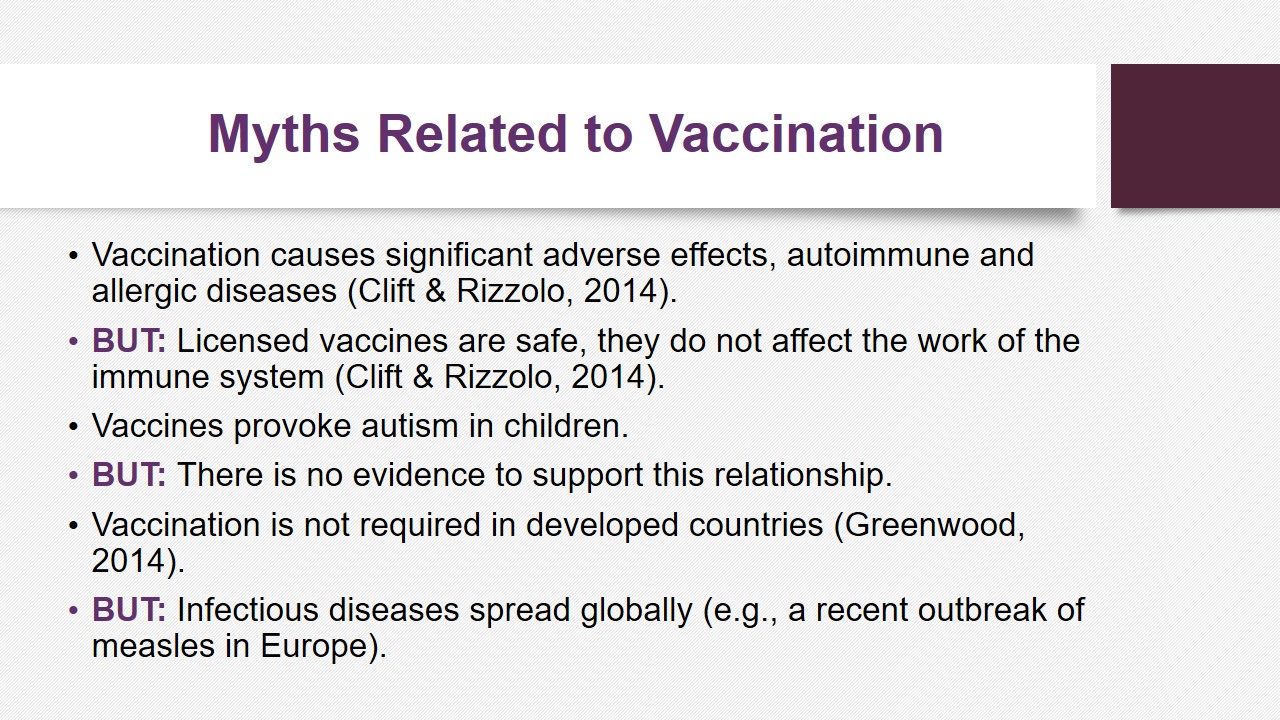
Disease Statistics for Conditions Prevented With Vaccination
- 100% reduction or eradication in smallpox;
- 99.9% reduction in diphtheria, measles, and rubella;
- 95.9% reduction in mumps;
- 92.9% reduction in tetanus;
- 92.2% reduction in pertussis (Ventola, 2016).
Effective universal immunization programs and policies have led to changing disease statistics for some conditions that caused morbidity and mortality in people decades ago. Vaccination has contributed to achieving the 100% reduction or eradication in smallpox and 99.9% in diphtheria, measles, and rubella. The reduction in mumps is 95.9%, in tetanus is 92.9%, and in pertussis is 92.2% (Ventola, 2016). These outcomes are results of recommending to use the following vaccines for children and adolscents: diphtheria, tetanus, and acellular pertussis, measles, mumps, and rubella, and tetanus, diphtheria, and acellular pertussis. Other standard vaccines are listed in the pediatric vaccination schedule.
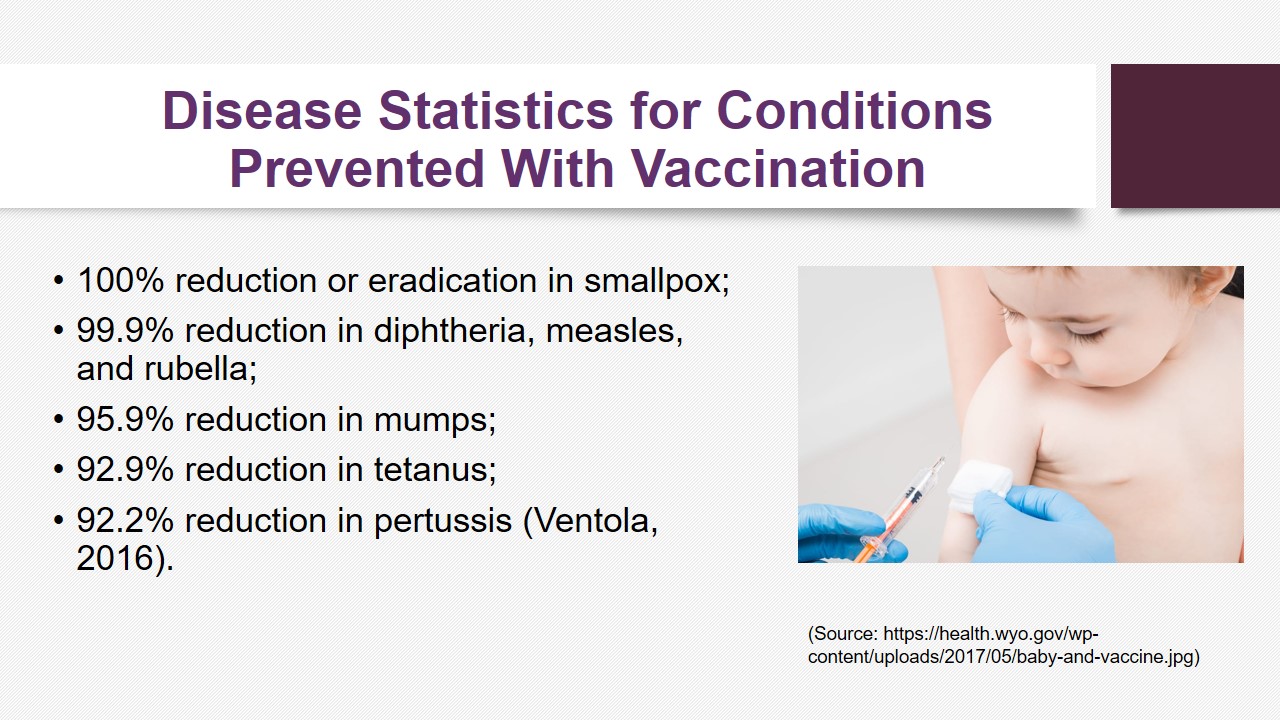
Immunization Schedule
The immunization schedule for children and adolescents is developed based on standard recommendations for vaccination to address childhood morbidity and mortality. In the United States, the pediatric vaccination schedule is approved by the American Academy of Pediatrics and the American Academy of Family Physicians. The schedule is based on children’s and adolescents’ age and their specific health conditions (Ventola, 2016). The vaccination guidelines are evidence-based, and they include vaccines against the following conditions: diphtheria, tetanus, and acellular pertussis, hepatitis A and B, inactivated poliovirus, rotavirus, measles, mumps, and rubella, pneumonia, and others presented in the table.
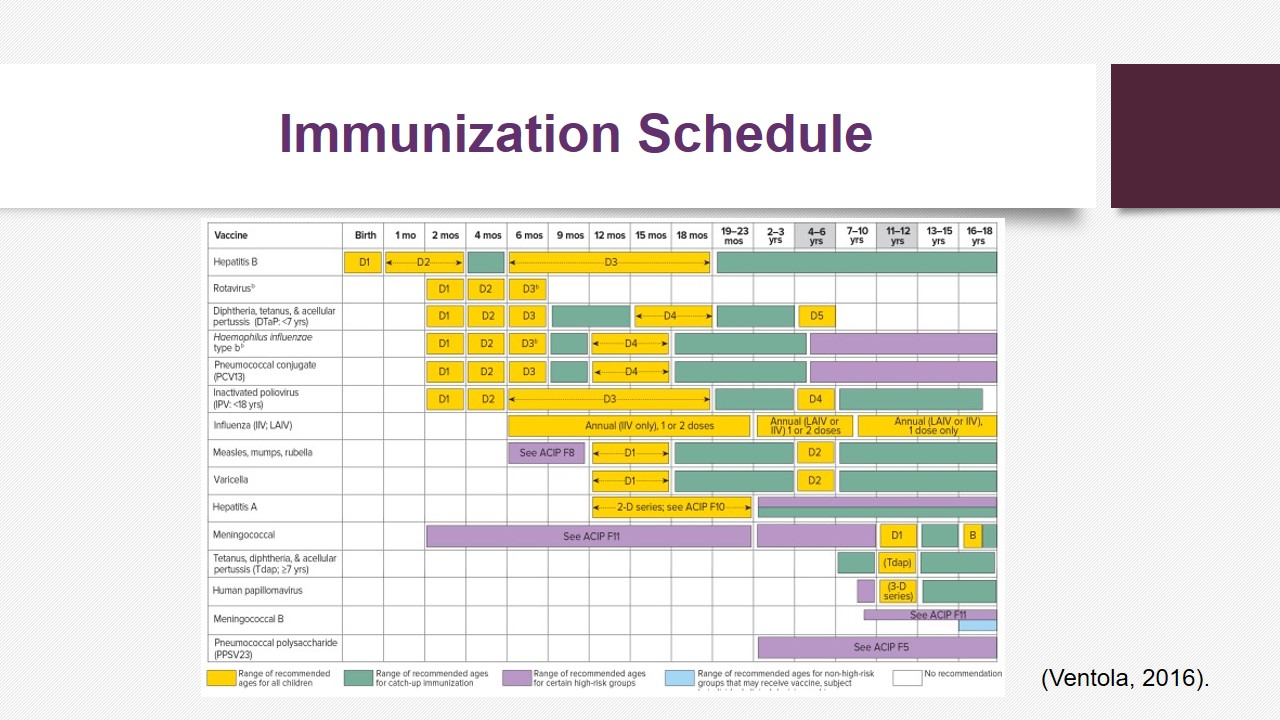
Legal Considerations
- All US states require children and adolescents to be vaccinated before entering school.
- Existing childhood immunization programs are mandatory.
- Legal exclusions related to immunization requirements (Weithorn & Reiss, 2018).
- In all states, parents can refuse vaccination according to medical exceptions.
- In 47 states, parents can refuse vaccination because of a religious exemption (Weithorn & Reiss, 2018).
- No developed policies and norms to punish the opponents of vaccination.
It is important to focus on legal considerations connected with the issue of immunization in the United States and note that currently all states in the country require children and adolescents to be vaccinated before entering a primary and secondary school. Existing childhood immunization programs are regarded as mandatory, but in reality parents can refuse vaccination. Thus, there are legal exclusions related to immunization requirements (Weithorn & Reiss, 2018). They cover certain religious, philosophical, and medical issues and exemptions. In all states, parents have legal rights to refuse vaccination if some vaccines are proved by a physician to be threatening for an individual child. In 47 states, it is possible to refuse vaccination because of a religious exemption, and policies in California, Mississippi, and West Virginia do not allow such exclusions (Weithorn & Reiss, 2018). The problem is that there are no developed policies and norms to punish the opponents of vaccination when their behavior leads to the spread of infectious diseases in a community.

Ethical Considerations
- Increased opposition against children’s vaccination.
- Threats of reoccurrence of vaccine-preventable illnesses.
- Families sharing pro-vaccination attitudes can experience difficulties accessing vaccines because of socio-economic factors (MacDonald et al., 2018).
- Parents need to receive appropriate education on vaccination and effects on children’s health (Greenwood, 2014).
- Parents should be educated regarding the concept of herd immunity and the role of immunization for communities.
Ethical considerations related to the question of immunization include the increased opposition against children’s vaccination and threats of reoccurrence of vaccine-preventable illnesses. Another issue is the fact that some families sharing pro-vaccination attitudes can experience difficulties with accessing vaccines because of social and economic factors (MacDonald et al., 2018). Parents cannot be opposed in their right to act for the benefit of their children in relation to immunization, but they need to receive appropriate education on vaccines and their effects on children’s health (Greenwood, 2014). Furthermore, they should be educated regarding the concept of herd immunity and the role of immunization for communities to make reasonable decisions. The lack of education regarding vaccination is one of the key ethical issues in this area.
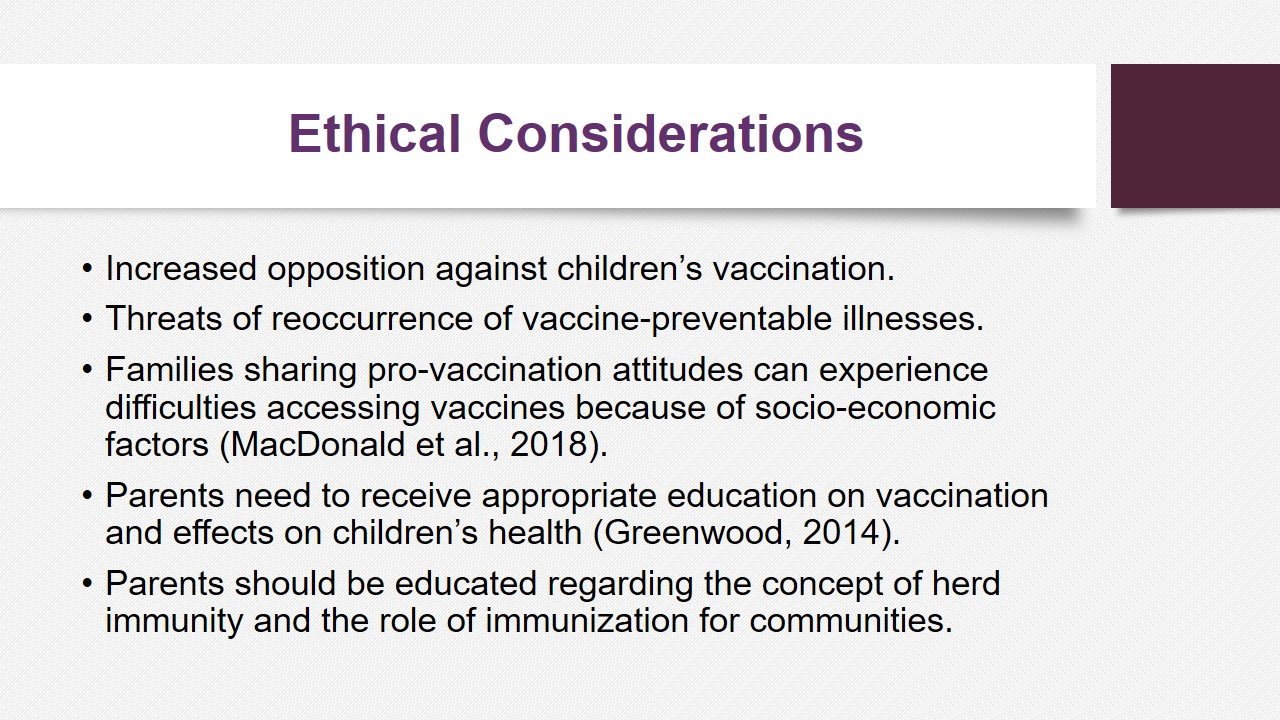
Cultural Considerations
- Vaccine hesitancy because of individuals’ religious, cultural, and personal views and beliefs.
- Media spread invalid information regarding vaccines, influencing people’s visions (MacDonald et al., 2018).
- Parents can share religious views, expecting children to develop immunity to diseases without medications.
- The balance between addressing individuals’ interests and avoiding threats to community health is required (Ventola, 2016).
- Possibilities for using penalty and access restriction are actively discussed in society.
There are also specific cultural considerations around the issue of vaccination. Vaccine hesitancy can be associated with individuals’ religious, cultural, and personal views and beliefs. The problem is that, in certain communities, media can spread invalid information regarding vaccines, influencing people’s visions (MacDonald et al., 2018). In addition, parents can share certain religious views, according to which their children are expected to develop immunity to diseases without using medications. Researchers are interested in finding the balance between addressing individuals’ interests and avoiding threats to community health (Ventola, 2016). Therefore, possibilities for using penalty and some types of access restriction for unvaccinated people are actively discussed in society.

Conclusion
- Vaccination is an effective method of health promotion and prevention of serious infectious diseases.
- Immunization programs adopted in developed and developing countries have contributed to decreases in morbidity and mortality associated with dangerous diseases.
- Some people still resist vaccination because of their personal views.
- It is necessary to improve parent education regarding immunization.
It is possible to conclude that vaccination is one of the most effective methods of health promotion and prevention of serious infectious diseases. Immunization programs adopted for developed and developing countries have contributed to significant decreases in morbidity and mortality associated with dangerous or life-threatening diseases. In spite of the fact that some people resist vaccination because of their personal views, it is one of the safest methods for preventing diseases. Therefore, to reduce possible health risks for children and adolescents as a vulnerable population, it is necessary to improve parent education regarding immunization.
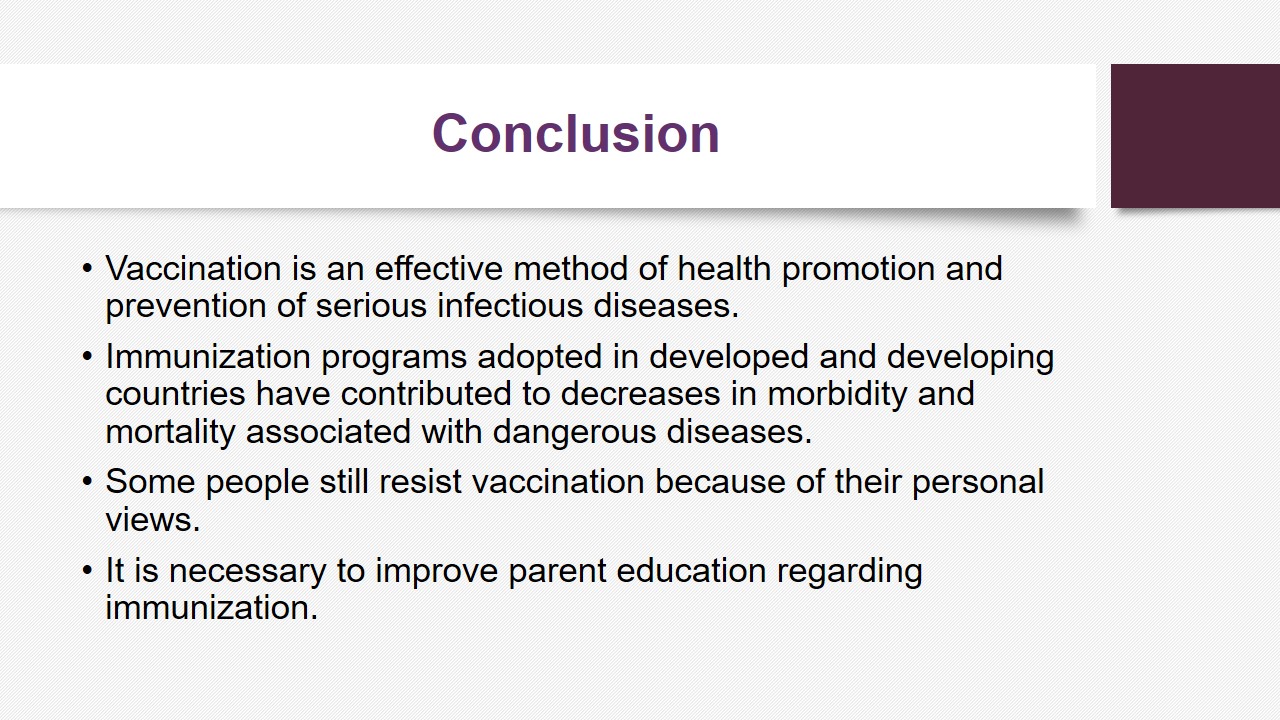
References
Clift, K., & Rizzolo, D. (2014). Vaccine myths and misconceptions. Journal of the American Academy of PAs, 27(8), 21-25.
Doherty, M., Buchy, P., Standaert, B., Giaquinto, C., & Prado-Cohrs, D. (2016). Vaccine impact: Benefits for human health. Vaccine, 34(52), 6707-6714.
Greenwood, B. (2014). The contribution of vaccination to global health: Past, present and future. Philosophical Transactions of the Royal Society B: Biological Sciences, 369(1645), 1-10.
MacDonald, N. E., Harmon, S., Dube, E., Steenbeek, A., Crowcroft, N., Opel, D. J., … Butler, R. (2018). Mandatory infant & childhood immunization: Rationales, issues and knowledge gaps. Vaccine, 36(39), 5811-5818.
Van Boven, M., & Van Lier, A. (2016). Global trends in vaccination coverage. The Lancet Global Health, 4(10), e670-e671.
Ventola, C. L. (2016). Immunization in the United States: Recommendations, barriers, and measures to improve compliance: Part 1: Childhood vaccinations. Pharmacy and Therapeutics, 41(7), 426-436.
Weithorn, L. A., & Reiss, D. R. (2018). Legal approaches to promoting parental compliance with childhood immunization recommendations. Human Vaccines & Immunotherapeutics, 14(7), 1610-1617.

